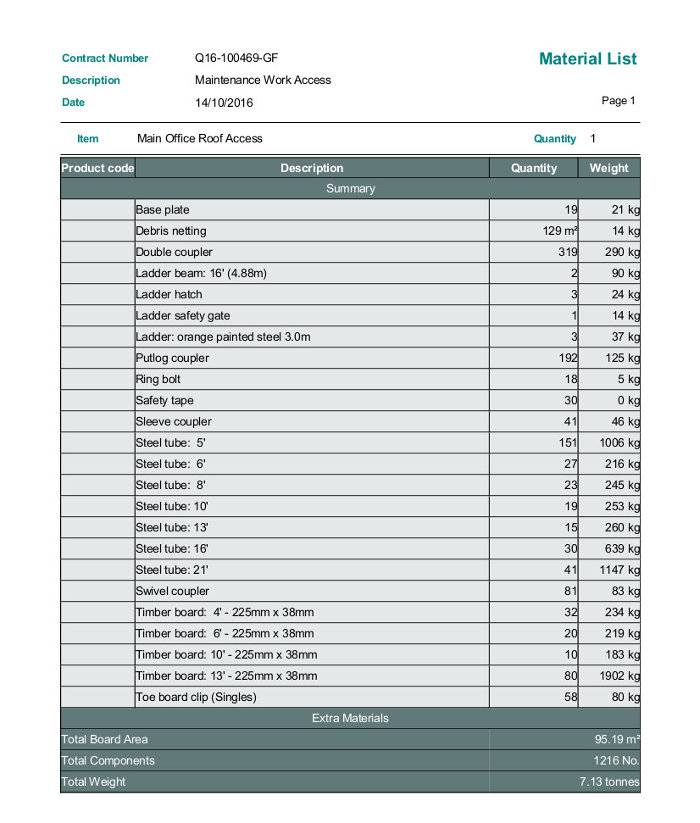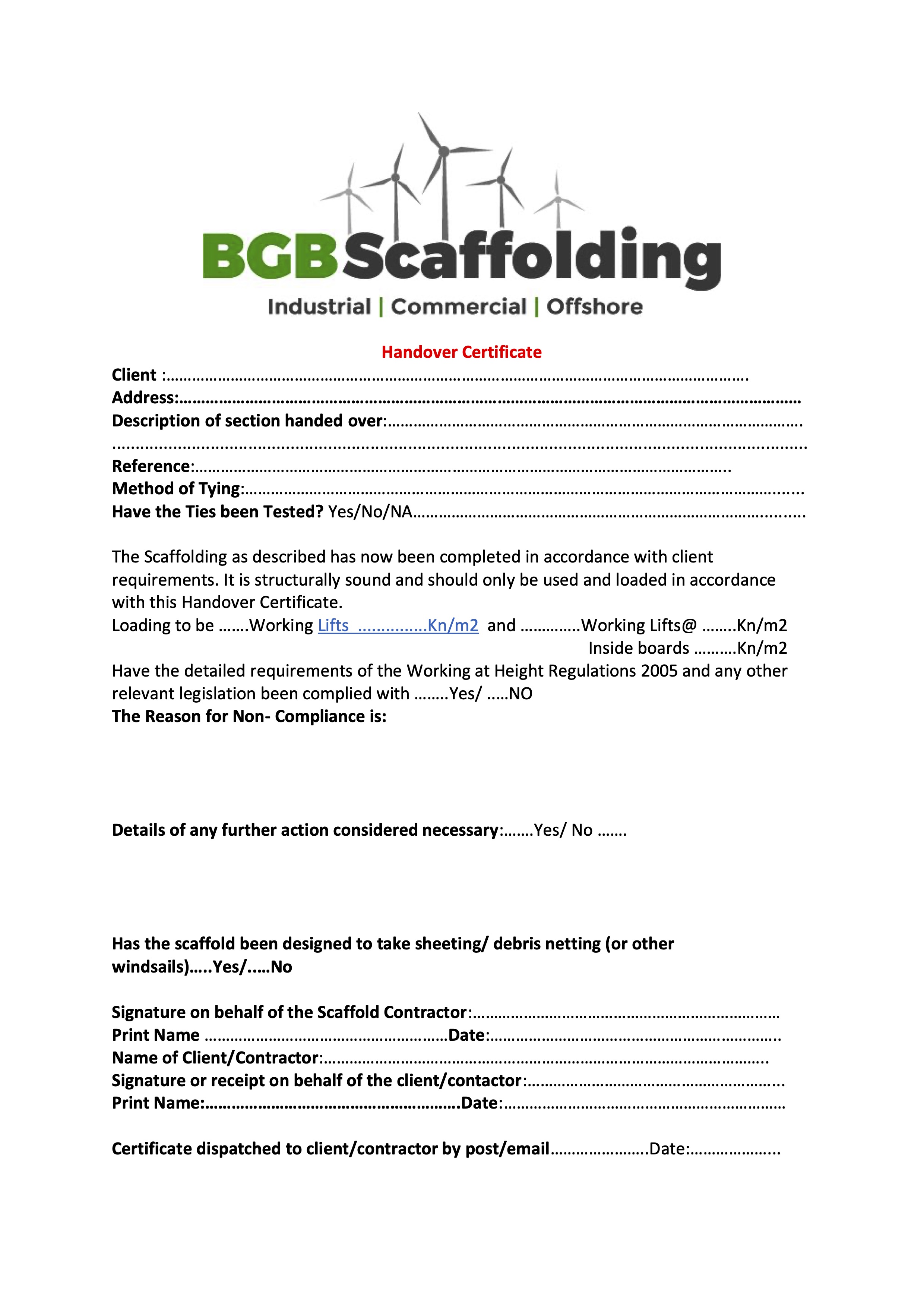Title Page
-
Conducted on
-
Prepared by
-
Location
-
BGB Scaffolding LTD working for:
-
Job Reference No:
-
Description of work to be undertaken:
-
Location of works to be undertaken:
Site Specific Inspection
BGB Scaffolding Ltd Site Specific Risk Assessment
-
ONLY TO COMPLETED FOLLOWING AN INSPECTION OF THE LOCATION CONDITIONS
10 Life Saving Rules
-
10 Life Saving Rules
RAMS Being Followed
-
Document:
- Outreach RAMS
- Racebank RAMS
- Biggleswade RAMS
- GOW03 RAMS
- Gabbard RAMS
- Fleetwood TAP RAMS
- NNG E & I Works RAMS
- EA1 RAMS
- Walney Basic Lifting Plan & RAMS
- ONSS RAMS
- London Array Rams
- London Array Shrink Wrap RAMS
- Changhua 1&2 Rams
- HOW02 RAMS
- HOW02 Shrink Wrap RAMS
- D017 - General Prefabricated Aluminium Tower
- North Hoyle RAMS
- 250 Single Tower Assembly Guide
- 250 Double Tower Assembly Guide
- D080 Haki Staircase Tower
- HOW02 RAMS Boskalis
- HOW01 RAMS
- HOW01 ONSS
- TJB RAMS
- National GridRAMS
- LS Cables Covid Rams
- DO79 - Independent scaffold
- DO45 -Free standing scaffold Interior Birdcage
- DO46 -Independent scaffold with cantilever
- DO48 - Independent scaffold with loading bay
- DO49 - Independent scaffold with bridge section
- RAMS for LS Cables
- D081 - Anchor Proof Pull Test Report
- D044 - Rescue & Emergency Plan
- LS Cables NG-BGB-01 Rev C
- Kincardine RAMS
- N/A
- HOW02 Staying Safe Offshore
Permit To Work
-
Permit to Work been issued
-
Number
Limitation Of Access
-
Limitation of access been issued
-
Number
Design
-
Design Number
-
Design Drawing
Significant Hazards Identified
-
Persons Falling
-
Objects falling
-
Adverse Weather
-
Manual Handling
-
Working Overhead
-
Access To Workspace
-
Slips, Trips, Falls
-
Work Equipment
-
Ground Conditions ( Where scaffold is being erected )
-
3rd Party Hazards
-
Moving Plant/Traffic
Persons at Risk
-
Own Employees
-
Other Workers
Ladder Access
-
Internal Ladder
-
External Ladder
Board Clamps
-
One per board
-
Two per board
-
Other specify
SG4:22
-
Working from floor level.
-
Working behind edge protection.
-
Use scaffold step.
-
Use twin tail lanyard.
-
Use Dummy lift.
-
Use Inertia reel.
-
Use of horizontal lifeline.
-
Use of mobile man anchor.
-
use of MEWP / Cherry picker.
Rescue Plan
-
This rescue plan is for the recovery of a scaffolder following an arrested fall from height whilst wearing a full body harness with a fall arrest lanyard attached to a suitable anchorage point.
▪ Each scaffolding operation shall be risk assessed prior to work commencing and the chosen rescue option shall be outlined on the accompanying risk assessment and method statement.
▪ All employees on site shall be briefed on the method of rescue to be adopted on this site before commencing the work activity.
▪ This plan outlines to BGB Scaffolding Ltd Managers, Supervisors and Employees the proposed means of performing a rescue of a person in a fall arrest situation as quickly and safely as possible.
▪ Falls shall be prevented by using collective means of fall prevention as per NASC’s SG4 (current edition) guidance.
▪ This document shall be reviewed as a minimum every 12 months, or where there has been a significant change in the matters to which it relates, if in doubt please consult your Line Manager.
Safety Critical Notes
Contact Details
Specification
▪ Rescuers must ensure that they always work within a ‘Safe Zone’ as per NASC’s SG4 & SG19 (current edition). This is defined as ‘a fully boarded and correctly supported platform with a single guardrail (at least 950mm high) where there is a risk of a fall’.
▪ Rescue is only to be attempted if it does not endanger the person carrying out the rescue or endanger the faller any further during the rescue attempt
This rescue plan is written and to be carried out in accordance with: ▪ The Health and Safety at Work Act 1974
▪ The Construction (Design and Management) Regulations 2015 ▪ The Management of Health, Safety & Welfare Regulations 1999 ▪ The Work at Height Regulations 2005
▪ Approved Codes of Practice
▪ NASC Safety Guideline SG4: & SG19: (current editions)
Page 3 of 10
Revision
D044 – Rescue Plan
Issue Date
01-20
Equipment & Plant
Emergency Arrangements & Rescue
▪ All plant and equipment will be fit for purpose and checked before use.
▪ Fall protection equipment including personal and specialist will be inspected and recorded weekly and 3- monthly Thorough Examination will be carried out competent person. A copy of these records will be retained on site and on BGB Server.
▪ Rescue plan to be put into effect immediately following a fall from height.
▪ Rescue arrangements will be as per site specific Rescue Plan and BGB Scaffolding Ltd specific emergency
procedures.
▪ BGB Scaffolding Ltd management and emergency services informed at earliest opportunity.
▪ Site specific rescue plan to be maintained in the site file. All employees to have been briefed and confirmed their understanding by signature before starting work.
▪ Rescue method:
▪ Rescue Plan 1 - Faller self-rescues or is assisted by colleague(s) ▪ Rescue Plan 2 - Rescue via Access Equipment
▪ Rescue Plan 3 - Rescue with Specialist Rescue Kit
▪ Priority to recover the suspended person from suspension as quickly as possible, without endangering, unnecessarily, the safety of the rescuer(s) or the casualty.
▪ Rescue team must not put themselves at risk during rescue and must comply with NASC Guidance Note SG4.
▪ Competent first aider to assess casualty and follow post-rescue actions from NASC Guidance Note SG19.
▪ BGB Scaffolding Ltd or the client to provide competent first aider and first aid facilities and equipment.
▪ BGB Scaffolding Ltd or the client to provide information on site specific fire arrangements and procedures during induction.
8.
Incident Reporting
▪ All incidents must be reported to BGB Scaffolding Ltd management as soon as practicable so that remedial action can be taken to reduce/prevent re-occurrence.
▪ All investigations to be conducted in liaison with BGB Scaffolding Ltd management and Fulcrum Scaffold Safety & Training Ltd, as per BGB Scaffolding Ltd Incident Reporting Procedure. -
Self Rescue / Assisted Rescue
-
8.1.1.Rescue Plan 1 – Self-Rescue/ Assisted Rescue
Scope: In the event of a person falling from an independent, tower, birdcage scaffold, or any other structure where there is access adjacent to the suspended person then the guidance below is to be followed:
▪ Self-Rescue – If conscious, then fallen person should recover themselves by climbing back onto a platform, or,
▪ Assisted Rescue - Colleagues assist fallen person back onto the platform. NB. If faller is unconscious they will have to be manually manoeuvred onto platform.
Pulling fallen person back into/onto scaffold
▪ This is a reliable option because it does not rely on plant or specialist equipment and rescue can be carried out by the scaffolders using conventional scaffolding equipment.
Erecting a temporary platform adjacent to the fallen person.
▪ Colleagues lay a full deck of adequately supported boards on the scaffold lift beneath where the fallen person is suspended, as close to the casualty as possible.
▪ Rescuers must work from a ‘Safe Zone’ or clip-on if working within 1m of an exposed edge as per SG4 requirements.
▪ Once in place, rescuers can lean out and pull the casualty back onto the platform. If the casualty is unconscious they must be manually manoeuvred onto the working platform.
Rescue by Ladder
▪ This is a quick method of retrieval but does have its limitations. When considering this option think if a casualty is able to climb down a ladder after the fall.
▪ Stand up the ladder situating it to one side of the casualty.
▪ Slide the ladder along the ledger until the casualty can place both feet on the rungs.
▪ When the fallen person is doing this always remember to foot the ladder securely, or fix in place, thus reducing the movement from the fallen person’s weight.
▪ Always maintain a good communication with the fallen person telling what actions are to be taken.
▪ When the fallen person is ready, he/she will climb up the ladder to un-hook their lanyard from its fixed point
and climb down whilst maintaining 3 points of contact on the ladder.
▪ Continue with Post-Rescue Actions. -
Special Equipment Retrieval Block
-
Scope: In the event of a fallen person being suspended from a cantilevered/ suspended scaffold, or any other structure, where there is no access adjacent to them then the guidance below is to be followed.
Use specialist remote rescue equipment to facilitate rescue, i.e. Rescue Winch Inertia Reel
▪ Prior to commencing works, scaffolder to be briefed on ‘Suspension Strap’ Toolbox Talk, and
▪ Specialist remote rescue equipment must be in place and connected to scaffolder before commencing the work
activity.
▪ Scaffolder to select sound anchor point above working position
▪ Connect anchor strop from rescue winch inertia reel to anchor point
▪ Connect inertia reel to D-ring on scaffolders harness
▪ If unconscious, the rescue must proceed as quickly as possible.
▪ Colleague(s) to perform rescue using the rescue winch on the inertia reel.
▪ Winch fallen person back to place of safety and assist them back onto platform
▪ Continue with Post-Rescue ActionsScope: In the event of a fallen person being suspended in free space below, or away from the scaffold structure (e.g. fall from Hung, Suspended, Cantilever, Truss-Out, Bridge or Temporary Roof) then the guidance below is to be followed.
Use access equipment to facilitate rescue, i.e. MEWP, Cherry Picker, Crane Basket, Mobile Tower or similar
▪ Access equipment and its operator must both be in place before commencing the work activity. ▪ Access equipment is only to be operated by trained and competent employees.
Page 5 of 10
Revision
D044 – Rescue Plan
0
Issue Date
01-20
▪ Access equipment is to be maintained, inspected and examined as per manufacturer’s information and statutory legislation before use.
▪ Refer to additional methodology for instructions on use and rescue from plant.
▪ Position the access equipment beneath the fallen person.
▪ If conscious, the fallen person may be able to assist by climbing into/onto the access equipment.
▪ If unconscious, ensure that the fallen person’s weight is supported adequately.
▪ Ensure that the fallen person’s fall protection equipment is released before moving the access equipment away
from the suspended position.
▪ Continue with Post-Rescue Actions -
Access Equipment MEWP
-
Scope: In the event of a fallen person being suspended in free space below, or away from the scaffold structure (e.g. fall from Hung, Suspended, Cantilever, Truss-Out, Bridge or Temporary Roof) then the guidance below is to be followed.
Use access equipment to facilitate rescue, i.e. MEWP, Cherry Picker, Crane Basket, Mobile Tower or similar
▪ Access equipment and its operator must both be in place before commencing the work activity. ▪ Access equipment is only to be operated by trained and competent employees.
Page 5 of 10
Revision
D044 – Rescue Plan
0
Issue Date
01-20
▪ Access equipment is to be maintained, inspected and examined as per manufacturer’s information and statutory legislation before use.
▪ Refer to additional methodology for instructions on use and rescue from plant.
▪ Position the access equipment beneath the fallen person.
▪ If conscious, the fallen person may be able to assist by climbing into/onto the access equipment.
▪ If unconscious, ensure that the fallen person’s weight is supported adequately.
▪ Ensure that the fallen person’s fall protection equipment is released before moving the access equipment away
from the suspended position.
▪ Continue with Post-Rescue Actions -
Rescue Actions Scope: Anyone suspended in their harness must be treated by a medical professional (even if they feel OK). First aid treatment alone will not suffice. All casualties are to be initially assessed by competent First Aider, following the standard First Aid treatment (ABC Management), as below.
First Aid Treatment
▪ First Aider to provide standard First Aid treatment (ABC Management) ▪ A & B – Assess casualty’s airway and breathing condition
▪ C – Check casualty’s pulse/ signs of bleeding
▪ Assess the level of consciousness using AVPU scale
Page 6 of 10
Revision
D044 – Rescue Plan
0
Issue Date
01-20
▪ A – Are they alert? Are their eyes open? Do they respond to questions?
▪ V – Do they respond to Voice? Do they answer questions/ obey commands? ▪ P – Do they respond to Pain? Do they open their eyes or move if pinched?
▪ U – Are they unresponsive to any stimulus (i.e. unconscious)?
Conscious Casualties:
If the casualty is conscious then the following process should be followed:
▪ Casualty should be encouraged to remain in an upright position and walk around if possible
▪ First Aider to remain with the casualty and accompany them to hospital for medical assessment
▪ First Aider should encourage the casualty to remain hydrated until reaching hospital. NB. This does not include diuretics such as tea and coffee; water is the preferred option
Unconscious Casualties:
If the casualty is unconscious then the following should be followed:
▪ First Aider to place patient in the traditional recovery position (as pictured) until the emergency services are in attendance.
▪ Advise the ambulance service that the patient needs to be treated
for orthostatic shock or intolerance, which should be treated similarly to crush injuries
Emergency Arrangements
-
ARRANGEMENTS: The emergency arrangements are as per site instruction, which will be briefed to operatives and Supervisors as part of the organisations induction process. if your working on a private property then the emergency arrangements are to call 999, if your in an area with no phone reception the call 112.
Control Measures (include any further permit to work requirements)
-
All work to be in accordance with TG20:21 and SG4:22
-
Work area to be segregated by warning signs, barriers
-
Raising and lowering materials to be in a controlled manner no bombing
-
To be carried out with manual handling training
-
By defined walkways/safe routes: use of ladders: special care going up / down stairs. Particularly if carrying materials
-
Objects to be cleared. Be aware of immovable objects
-
Scaffold materials to be checked before use
-
Smoking in designated areas
-
Ensure adequate tying before access as per RAMS
-
Wear ear defenders when using drills
-
Wear all PPE and inspect before and after use
-
Tool teathers to be used at all times
-
Materials not to be left in walkways. Spare materials to be removed from site
-
Complete and go through all documents with BGB Scaffolding Staff, homeowner, and Other Contractors
-
Area to be barriered off to protect from vehicles and plant machinery
Communication Of Control Measures
-
I confirm I have been instructed and understand the control measures required for this work, as detailed in this assessment. If the work situation changes and additional hazards identified I will bring to the attention of my immediate supervisor
-
Name
-
Name
-
Name
-
Name
-
Name
-
Name
-
Name
-
Name
-
Name
-
Name
-
Name
-
Name
-
Name
-
Name
-
Name
-
Name
-
Name
-
Name
-
Name
-
Name
-
Name
















